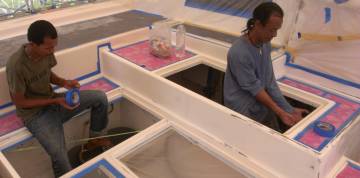
Baw and Lek preparing the cockpit for Mike's gelcoat spray
80 Spraying Gelcoat
 Baw and Lek preparing the cockpit for Mike's gelcoat spray |
Summary: A productive week! On Monday, Mike started and Baw finished spraying much of the flooring area of the cockpit with gelcoat. Then Mike loaned us his big gelcoat gun and Baw got on a gelcoat spraying roll. On Wednesday he sprayed the big deep cockpit lockers, on Thursday he shot the aft‑deck, lazarettes, and helm seat, and on Friday he shot the chain lockers and the entryway steps! AME's machinists drilled out our 14 mast tangs and (eventually) pressed in stainless steel inserts. The fo'c's'les and one chain locker were painted with primer. We found that the Nippon epoxy paint sold to us by cruising friends doesn't perform well at all, and a lot of time was spent removing it. We decided to use Sikaflex to stick down the teak in the cockpit, instead of epoxy, and Mike delivered 2 fresh cases from Bangkok to put in our fridge. We removed the vertical davit supports and Mike took them to the powder coaters to get painted. Jon and Amanda built a small mold and glassed up a shelf for the washing machine. They also de‑cored and filled the bolt‑holes for the anchor winch, and worked feverishly (between gelcoat sprays) to finish the difficult curved nonskid templates. We bought more acrylic and Houa cut it up to make more of our toothbrush holders. Houa also started making the long toe‑rail to go across the aft‑deck, behind the cockpit. On Saturday we left early to visit friends in Ao Po to begin a weekend‑long celebration of our 34th wedding anniversary.
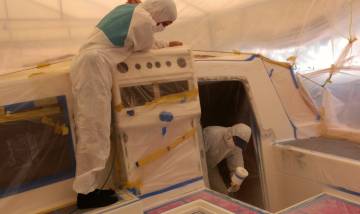 Jon, on hose duty, watching Mike spraying from the entryway |
Monday, May 13:
Oh Glory Be! A beautiful day with blue blue skies and a light breeze. Perfect day for
the Great Cockpit Gelcoating.
We had several interesting things happening around Ocelot today. Amanda and Sue arrived to find Baw, Lek and Pla finalizing the masking for today's gelcoat spray in the cockpit. They hung polyethylene on three sides of the cockpit, and built a plastic cavern into the salon so that Mike can stand inside and spray out, and then spray back towards the salon without getting overspray on anything real in there. They also put plastic sheeting over the open cockpit lockers, as we found the white future‑board too tempting for a foot, and then we'd have had an accident.
When Mike arrived he checked the last minute sanding and acetone cleaning, then got ready to spray. Jon also got in a bunny‑suit to hold the excess hose and to help Mike navigate around the cockpit. Mike started spraying at 11:30, working his way from inside the salon to the outer cockpit on starboard side, then moved to port side. After 1½ hours he was not doing well. He had a massive headache and looked quite piqued. Turns out the "cavern " we built for the salon held all the styrene fumes in there, and he was basically polyester poisoned. A good activated charcoal respirator and some sort of glasses windshield wiper would have stood him in good stead.
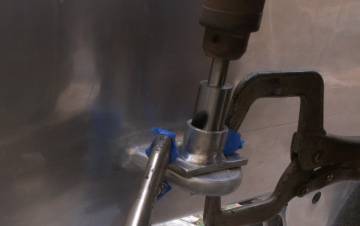 Drilling out the mast tang holes with a clamped on drill-guide |
Luckily, Jon recognized that Mike was flagging, so he recruited Baw from his lunch and asked him to suit‑up and be ready to step in. Baw was a good sport. He refused a Tyvek suit, but put on an outer long sleeved shirt. He did, however, wear a good respirator. At 1:30 Mike asked Baw to take over the spray. Baw finished all the aft‑most hatch rims and the entire aft cockpit seat, front and back. By 3pm they were done, and we had a gorgeous freshly painted looking cockpit!
It was interesting to note the differences in their styles. Baw is used to a much smaller gun than Mike's 4mm monster, so Baw tended to shoot with smaller movements from much closer in. This seemed to reduce the over‑spray, and certainly delivered the gelcoat more accurately, but Mike's broader strokes from further away probably produced a smoother finish. One nice thing about this spray - unlike our other deck sprays, this is (hopefully) our final spray in the cockpit. Now we just need to polish it up...
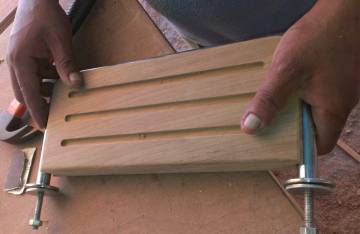 Houa's new teak step for the cockpit |
Two machinists came from AME to work on our mast. We have 18 tangs welded onto the mast with holes for the rigging, but only 4 of the holes have stainless steel inserts. The other 14 are bare aluminum, and now some of the holes are more oblong than round. So we've contracted with AME to drill out the holes and sleeve them with stainless steel inserts. Today they drilled out all the holes in the tangs, and reamed them out to the correct diameter for the inserts. To drill the holes exactly perpendicular to the tangs they built a small drill‑guide that they clamped to each tang.
Tomorrow they should return, with a small hydraulic jack, a steel frame so the jack will work as a press, and the stainless steel inserts sitting on a block of dry‑ice. We'll position the jack and its frame above the hole in the tang, put a frozen (and therefore, slightly shrunken) insert into the hole, and press the insert in. We hope...
Meanwhile, Pla, Ben and Lek were busy with International Primer 670, which is a 2‑part epoxy primer that should help bond the white paint layer to the fo'c's'le walls and overhead. Ben worked in starboard with a roller, while Pla was in port with a paint brush. Later in the day we discovered that the Nippon epoxy paint we had used on the hatch covering within the fo'c's'le peels off too easily, and is sort of soft and rubbery. Definitely NOT the finish we want in hard use areas like the fo'c's'les and cockpit lockers. Two steps forward, 1 back. We have decided to strip off the new Nippon paint and find a better alternative. It would drive us nuts to have the "new" paint peeling off within days or weeks of launching.
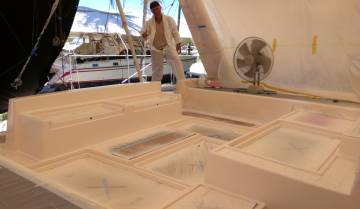 A difficult spray, with so many small fiddly bits |
Houa spent the morning working on small outside contract jobs for cruising friends of ours (he told us beforehand). In the afternoon he finished the teak helm step that is rimmed in stainless steel. It looks fantastic. Tomorrow he will check his teak cockpit plans with the dimensions of the cockpit floor, now that we have newly gelcoated edges!
Team Hacking had a strange day. Jon donned Tyvek suit and spent the entire spray time (about 4 hours) up in the cockpit with first Mike and then Baw. His job was to be sure the painter didn't fall into the lockers, or get stuck on the gelcoat overspray on the floor which was terribly sticky, and to keep the compressor hose out of the new gelcoat. He was, well, almost completely successful. We had a hose blooper, and a couple "sprayer‑caught‑in‑sticky‑overspray" events. But nothing that can't be fixed post‑spray.
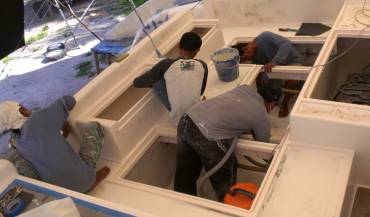 Sanding the new gelcoat & preparing the cockpit lockers |
Sue varied her photographs between Houa's workshop, the fo'c's'les, and the cockpit. Amanda took advantage of the relatively "down day" to rent a scooter and take herself off to touristy Patong to look for little "retuning home" gifts for her friends.
Tuesday, May 14:
Another beautiful day in paradise! Today's gains were more in decisions made than work
accomplished.
We were happy to find that the new gelcoat in the cockpit is nice and hard! So the first order of the day was to remove the masking and sticky over‑sprayed vinyl. Baw and Lek got busy right away with buckets of water and 400 grit sandpaper to smooth the aft side of the cockpit seat, which is a fairly large, vertical surface. Throughout the day they moved around to other large areas. They pretty much avoided the rims of the cockpit lockers as Houa wanted to work there.
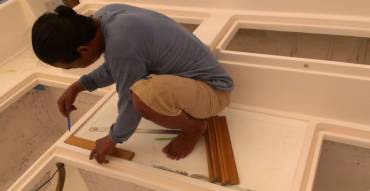 Houa working out where he wants to lay the teak decking |
Houa brought up several carefully cut teak boards to check dimensions in the cockpit and to mark out the mitered corners. He is basically sticking to the original teak pattern insofar as the boards will all align from one area to the next, fore and aft. The new thing is that he is making larger "king" boards, the teak frames around each teak area, which are usually a different size from the interior boards. He says he can do this to make it more beautiful, and that the other boards will still all line up perfectly. Skeptical Sue and Amanda had to get a quick demonstration, so Houa showed us how it would work, and it looks fine.
We have been trying to decide if we want the teak deck stuck down with an epoxy glue like Hartford, or a polysulfide mastic like Sikaflex. Houa has used both successfully, but he doesn't usually get to see the long‑term results of his work. The epoxy is probably stronger, but it doesn't allow any movement at all, whereas Sika is more forgiving. Over the years we've learned that different materials expand or contract at different rates as temperatures change. Specifically, teak and fiberglass have different thermal coefficients of expansion, and a little flex between them is probably a good idea. Epoxy also has trouble adhering well to oily materials, and teak is a notoriously oily wood. Sika is a bit more expensive, but not that much more expensive.
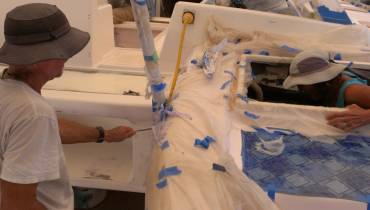 Jon & Sue removing the thick davit supports to get painted |
Given all that, we decided to use Sikaflex 298 to bed the teak to the fiberglass‑epoxy deck. So when Mike came around just after noon we ordered a case of fresh tubes, to be shipped down from Bangkok.
One piece of news that Mike brought us is that the powder‑coaters are about to do a run with the same color as our gelcoat, and did we want them to do our davit supports? We certainly did! Everyone who comes on board Ocelot grabs those supports and they're now filthy, with lots of old epoxy stuck to them. So we quickly shifted the solar panels, which are on top of the davits, forward so they rested more on top of the targa‑bar. Then we could remove the single large bolt at the top and the 4 smaller bolts at the bottom of each davit support, and remove the supports for Mike to take to the powder‑coaters.
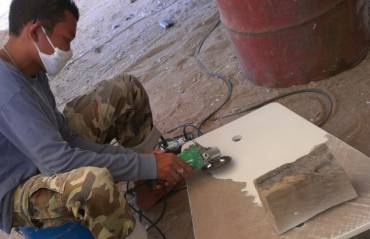 Ben removing bad Nippon epoxy paint from a hatch |
The weather here has been absolutely gorgeous since the storms on Sunday, but another bit of news that Mike brought is that there's a cyclone about to smack into Myanmar, and it's likely to bring wind and rain to Phuket over the weekend. This weekend is our 34th wedding anniversary, and Amanda is returning to the US on Monday, so we were planning to visit friends up north for a combination party. Guess we'll have to see how the weather plays out.
Another decision was what to coat the insides of the newly sanded fo'c's'les, chain lockers, and cockpit lockers with. All 3 originally had gelcoat, which was looking pretty ratty after 18 years. We were putting primer in the fo'c's'les in anticipation of then using a Nippon 2‑part epoxy paint. But now that we see how soft and rubbery that paint is, we nixed that idea. Baw recommended Jotun Penguard, which he's used before. But talking with the guys we realized that gelcoat will give us the most longevity. So we asked them to stop putting primer in the fo'c's'les, to sand off the new primer in the port chain locker, and to prep the big cockpit lockers for gelcoat!
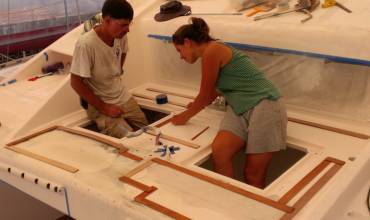 Jon & Amanda working out where the nonskid panels will go |
So, part of the day was more steps backwards and part moving forward in (another) new direction. Down below Ocelot, Ben spent the day taking OFF the Nippon paint from the foc's'le interior hatches. Pla stopped putting on primer in port fo'c's'le and concentrated on sanding and cleaning the cockpit lockers. Houa even took time to help with the cockpit locker, taking off the drain hoses and part of the propane bottle hoses. (Will we EVER stop taking things OFF of Ocelot??)
Baw said that he can spray gelcoat tomorrow! We'll rent a compressor, hose and paint gun from EU, and use our own Ocelot White gelcoat. We considered using Thai white gelcoat, but decided not to because our gelcoat is more water resistant than the Thai gelcoat. Also, one of our 20 liter drums of gelcoat has been open for 4‑5 months and is nearing the end of its shelf life, so we want to use it up.
Jon and Amanda got a few more foredeck templates made for the nonskid, and Mike came by and picked them up.
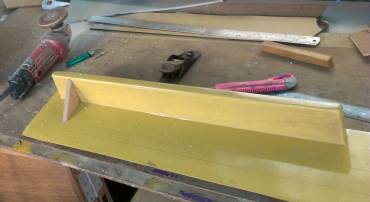 Jon's quickie mold for the washing machine shelf |
Jon's afternoon project involved our washing machine. When we're cruising it lives down the port fo'c's'le but our new one, made in China, has to be high enough for the water to drain out by gravity - it has no pump. So it needs a shelf to stand on. Rather than build a big shelf that would limit access to other things in that fo'c's'le, we'll make it a tiny shelf for just the back feet, and tie the washing machine to the strong, water‑tight bulkhead between the fo'c's'le and the forward cabin.
So we'll make the shelf the width of the fo'c's'le hatch, about 2' (60cm) long, but only 3" (7cm) wide. To make the mold, Jon found an old board about that size, trimmed it down, sanded it smooth, and super‑glued it to another old board so they form an L. Then Jon and Amanda covered both boards in yellow‑brown packing‑tape, which epoxy doesn't stick to. While Amanda went to cut the strips of fiberglass, Jon built 2 little triangles out of thick scrap acrylic, to brace under the shelf where the feet of the washing machine will be. But we didn't have time to actually lay it up, so we'll do that tomorrow.
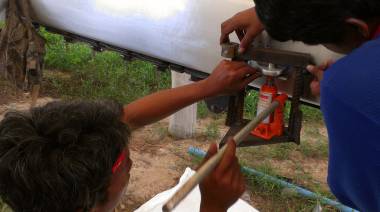 AME machinists trying to press a bushing into a mast tang |
Wednesday, May 15:
Another good day at the yard, although it was a bit slow on the uptake.
We had a bright sunny morning and had thought we'd have a gelcoat spray early on. But according to Houa, "Baw had accident with stomach!" and didn't show up until close to lunch time. We interpreted this as Baw had too much to drink last night. But no worries, our other 2 faithful workers, Pla and Lek, had arrived near 8am and set about preparing the deep cockpit lockers and the aft deck by the lazarettes for the gelcoat spray. This involved hand sanding (lightly, to clean) and wiping with acetone. They also sanded (roughed up) the new gelcoat on the aft most part of the aft deck where Baw will be joining with more gelcoat.
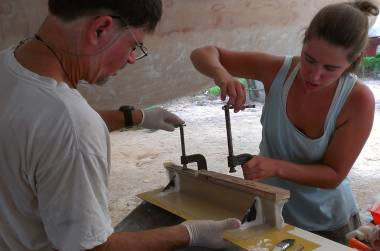 Jon and Amanda clamping the finished glass onto the mold |
Mike came by to say that the powder coaters might be finished with our dinghy davit supports tomorrow (so he needed money!) He was also there as a liaison with Wiwat's machinists, who arrived with a cooler of dry ice, our new bushings for our mast tangs, a 2‑ton hydraulic jack, and a frame for that jack. The idea was to set up the frame around a tang, get everything positioned, pull out a chilled bushing, place it correctly to get pressed into the hole in the tang, and quickly use the jack to press the bushing into place.
This was obviously a new procedure for them and they didn't understand it, which led to the inevitable failed result. They didn't understand that they had to press the bushing in before it warmed up and expanded, so they left it perched on top of its hole while they futzed with other things. They eventually got one bushing pressed about 60% of the way in, but then it cocked over and got stuck so it had to be pounded out. They reamed the holes out as much as they could but that didn't help. Eventually Mike asked for Jon's digital calipers so he could measure the holes and the bushings. Instead of the .001" (.025mm) interference fit they'd planned on, the bushings were measurably larger. So they packed up their equipment and headed back to their shop for another try...
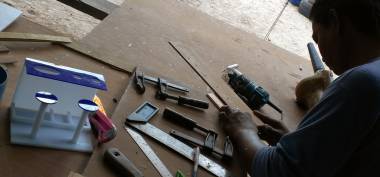 Houa cutting out acrylic for more toothbrush holders (on left) |
We also told Mike that Baw would be gelcoating the cockpit lockers today, but that we hadn't been able to find a spray gun with a bigger nozzle. EU has one with a 1.5mm (.06") nozzle, which is really made for fine paint work, not thick gelcoat. Mike told us we probably would not find a larger one in Phuket, as there just wasn't a call for them. Then out of the blue he suggested that we borrow and use his 4.0mm gun, which was in the back of his car! Wow! We were very pleased, and requested a full lecture on how to care for it and clean it.
Amanda spent the morning at a local coffee shop, enjoying a fruit smoothie and applying for a research position in Seattle. The internet has been down at our apartment for over 24 hours, and it was bad timing for Amanda, but she got her application submitted, then joined us at the yard. She and Jon laid up the fiberglass for the washing machine shelf on the mold that they'd made yesterday. Since the glass had to go over 2 right angles, Amanda cut the glass with the strands at 45° so the strands would go over the corners more easily. They put on 7 layers of woven glass, and then epoxy mudded in 2 triangular acrylic braces. By the end of day it was setting up well.
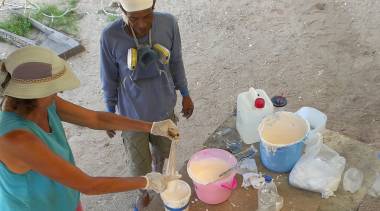 Sue straining gelcoat through nylon stockings to remove lumps |
Houa had an interesting day playing with acrylic for us. At Christmas Amanda made us a really cool acrylic holder for toothbrushes, toothpaste and 2 cups. It looks a bit like a miniature bar and bar stools. Anyway, with her imminent departure for the States, Jon reminded her that he never got the other 3/4 of his gift... i.e. the other 3 holders! Amanda and Sue had scootered into Phuket Town yesterday to buy more 6mm (¼") acrylic, and they took that to Houa to do all the cutting for the holders. Now they just have to be glued together and we'll have 4 matching, spiffy toothbrush holders. Sure will beat the metal‑turned‑to‑rust ones we had before!
The big job of the day was the gelcoating of the cockpit lockers, which began in earnest about 2:30. Surprisingly, the guys asked for a scale so the gelcoat could be weighed accurately. This was a huge win for us, as we've been trying to get the guys to be more scientific with their mixing. So we dug out our scale (bought just for that purpose) and they asked us to mark 2 syringes with blue tape to show the correct quantities of mono‑styrene and catalyst to add. Cool! Talk about teaching old dogs new tricks! We were impressed and pleased that they wanted to do it the accurate "chem class" way!
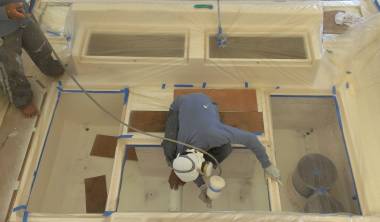 Baw shooting gelcoat into our big under-cockpit lockers |
We had a hiccough when Mike's 4.0 nozzle spray gun seemed to be blocked. The guys cleaned it, sprayed mono‑styrene and acetone through it, and tried again. No luck. Then we realized that this can of gelcoat has been open for 3 months, and may be thicker than normal. So we called Mike, who gave us the maximum parameter for thinner (mono‑styrene). Sue and Lek were the ground support, decanting, straining, measuring, and weighing the gelcoat. So they increased the mono‑styrene from 30ml/kg of gelcoat (which is what Mike used yesterday, and had advised as a starting point for today) to 50ml/kg. The gun worked famously after that.
Baw began the spray at 3:15 and he finished at 5:15. It took about 7 kilos of gelcoat to cover the huge locker area. Pla was the man tending the hose for Baw. Jon and Pla re‑filled the gelcoat pot when needed and added the catalyst (or "hardener" as they call it, which it isn't). Part way through the shoot Baw asked for mono‑wax to be added, so we put in a bit less than 1%. This gelcoat already has mono‑wax in it, so this just increased its rate of jelling, and made sure thin areas would not be sticky. Everyone helped with the clean‑up, but Sue took on the all‑important job of cleaning Mike's gun. The guys put a bit of mono‑styrene in the pot and sprayed that out (the compressor was off at this point, but still had pressure) then they repeated it with acetone. Then we took the whole thing apart and put it into acetone. Although Mike had suggested using a 1" paint brush to clean the gun, Sue used an old toothbrush and got much better results. It was stiffer, smaller, and didn't drop its bristles!
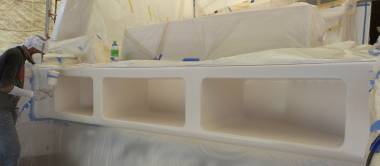 Baw shooting gelcoat on the lazarettes, behind the cockpit |
Tomorrow we hope to spray the aft‑most part of the cockpit: the lazarettes.
Thursday, May 16:
A fun day at the Ocelot Circus Tent. French cruising friends told
us this sort of tent over the boat is called a "chapiteau" which translates as
"circus tent." Very apt.
The big job today was once again in Baw's jurisdiction. Early morning found Lek and Pla doing a final sand and acetone wash on the aft‑most lockers, or lazarettes, where the life raft and fuel jugs are stored. Baw got the whole area masked off, and by 10:30 he was up on the scaffolding spraying gelcoat. Pla was the hose‑attendant while Sue and Lek did the weighing, mixing and catalyst adding. They all seemed to make a good team. Baw was worried about getting the big tall gun (with paint pot) into the space, and claimed it would be not possible to do. He thought if he turned the pot sideways the paint would drip out. We told him it was not a very important area, and he should just do the best he could. In fact, he decided to give it a go by filling the pot only half full, and that worked really well. The spray was finished by lunchtime.
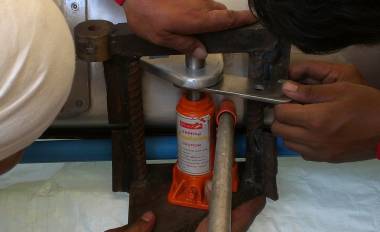 AME machinists pressing in a mast tang bushing |
Houa got the fiddly jobs today, which is unfortunate, as he is such a fine craftsman. But he is waiting for the cockpit to be prepared, and for new, fresh Sikaflex to arrive from Bangkok (via AME) which is due Monday. He also wants to cut out the new larger hatch openings in the forward cabin headliners. But we kept thinking that he would be inside the boat with gelcoat spraying and no one wanted that, so we didn't make that job happen. Instead, he took on the job of sanding the new Nippon epoxy paint off the locker and fo'c's'le hatches. Of course, being efficient means that he got the whole job done in one day, when our lower paid workers might have taken 3!
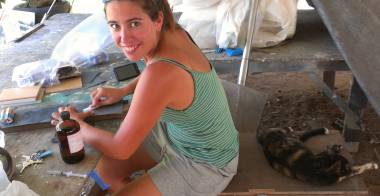 Amanda (and cat) working on acrylic toothbrush holders |
Amanda and Jon pried their new fiberglass shelf for the washing machine off its mold... and pry it they did. Even had to grind some of it off. Guess the slick brown tape wasn't as good at releasing as we thought! Jon trimmed off the rough edges, sanded it, and marked where it has to be mounted in the port fo'c's'le. So we now have a cool fiberglass shelf for the washing machine to sit on. Next job: epoxy it into place.
Amanda got to hide from gelcoat spray, mosquitoes and the sun by sitting under the neighboring catamaran on our tool box (accompanied by Turtle, the yard cat). She made some good progress on sanding the bits and pieces of the acrylic toothbrush holders.
The machinists from AME came by again, and made more progress on the mast tang bushings. They had a few setbacks, in that one of the tangs was marked with the wrong size, and some of the bushings were too small so they sort of fell into place (and fell out again). But they DID get some of the bushings put in place (bare hands handling dry‑ice frozen metal) and pressed into the tang hole correctly. We'll get there.
After lunch we found Baw and Lek sanding the back 2 sides of the helm seat, getting ready to give it an acetone wipe and a gelcoating. Cool! We hadn't even thought to ask them to do it, as we had thought it was part of Mike's contract. But if they wanted to do it, we're certainly not going to stop them. We just need the job done! And it now looks beautiful. We can almost see the big helm seat back in the cockpit!
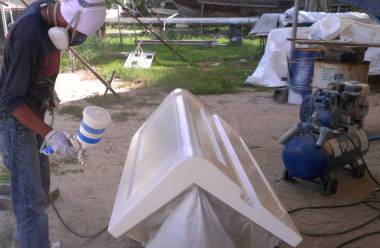 Baw shooting gelcoat on our big cockpit seat |
The other areas Baw wanted to do in the afternoon were the steps near the companionway, which for some reason appear too thin after Mike's spray. Also targeted were the 2 chain and anchor lockers on the foredeck. In Theory (which is an area we've been to often, but don't always believe in) one can spray gelcoat over a good, well‑cured 2‑part epoxy primer, such as the International 670 we put in the port chain locker a few days ago. But Baw said, "Not sure - Up to me, I take off." So, given the incredibly rough handling the anchor locker gets, we've decided to go ahead and sand off the primer and then spray the locker with gelcoat. As an experiment, we'll leave the primer on the upper surface (ceiling) of the locker, and spray over it. Then we get to see if it sticks or not on an area that's not important.
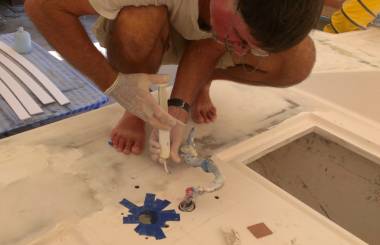 Injecting epoxy into anchor winch holes above a chain locker |
Meanwhile, Jon and Amanda took on the project of injecting epoxy mud into the de‑cored windlass bolt holes on the foredeck. (Is there any chance this will be the LAST de‑coring necessary?) This was about an hour‑long job, which meant no one could sand the anchor locker at the same time, nor could Baw spray up there. They finished after 4pm, and by 4:20 the guys had pretty much picked up the gelcoat set‑up for the day, with Sue doing her gun cleaning magic once again. So, the de-primer-ing and the re‑gelcoating will wait until tomorrow. Everyone went home a bit early, which was cool as they had all stayed an extra half an hour yesterday to finish the spray job.
Friday, May 17:
So far so good on the week, with more (forward) activity. But it was overcast all day, with
on and off drizzle.
Once again, Baw was the hero of the day. He and Lek spent a couple hours sanding the new gelcoat on the aft area around the aft lazarettes. Meanwhile, Pla power sanded the (new) primer off the port chain‑locker as we requested. He then cleaned both chain‑lockers with acetone.
The guys built a big plastic enclosure over the foredeck so Baw could spray gelcoat into our chain‑lockers. To provide Baw with some good air they rigged a fan on the port side to blow air into the enclosure, and to contain the overspray they setup the extractor fan to suck air out of the starboard side. Everything was prepared and masked before lunch.
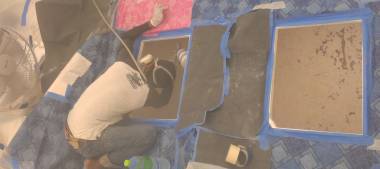 Baw spraying gelcoat into the chain-lockers on the foredeck |
After lunch Baw climbed into his plastic house and gave the insides of our two chain‑lockers a beautiful spray of gelcoat. Jon and Pla were the on‑deck assistants, while Lek took care of things below, like straining and measuring more gelcoat. This shoot was difficult because vast quantities of gelcoat over‑spray was blowing back at Baw. If he could see where he was spraying, atomized gelcoat (and the noxious fumes associated with it) was blowing into his face. Each locker took him 30‑40 minutes to spray, and he emerged with a light frosting of gelcoat all over him and his clothes.
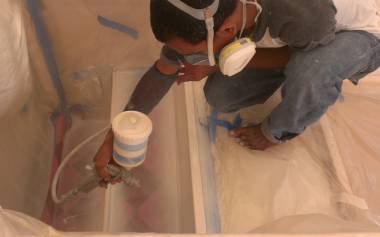 Baw re-spraying the steps from the entryway to the cockpit |
Then Baw had to quickly re‑spray the steps leading down to the entryway, in the cockpit. Mike says he shot a ton of gelcoat onto those steps on Monday, but they obviously needed more. Baw had to hurry because we were using E‑U's compressor, and he needed it back to do a shoot on another boat. Luckily, the step areas are small and Baw finished spraying them in about 10 minutes. We are now researching new engines for Golf's old compressor so we don't have to borrow E‑U's. The Chinese copy of a Honda motor driving Golf's compressor (which we have now claimed as our own) has now officially died.
Sue was happy to see that Baw and his team seem to have the gelcoat procedure down pat, with scale, syringes, etc., so she begged off the gelcoat work until time to clean Mike's 4.0mm spray gun. She also cleaned up, de‑rusted, sanded, and de‑siliconed a lot of small bits of hardware and got more hand sanding done on the aluminum brackets for the forebeam. We won't be doing Nyalic this weekend as we have party plans with friends.
The machinists from AME came by, again, and finished pressing the last 4 bushings in place on the mast tangs. Perhaps more importantly, Mike came by and delivered $830 of Sikaflex for Houa to use building the teak floor for the cockpit. While he was with us, Mike pulled out his moisture tester and determined that the teak Houa bought has less than 10% moisture, which is very good.
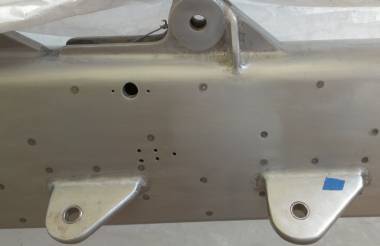 Finally - mast tangs with stainless steel inserts pressed in |
Houa was back to carpentry work today, much to his pleasure. He began making the big board that goes all the way across the aft deck, on the outer edge. This acts as a small barrier so things don't just roll off the deck. It will be about 2" (50mm) wide and 1.3" (30mm) high, with 5 drain slots cut into it so we can drain rain (or sea) water off the deck. At first Houa thought to place it forward of the gelcoat aft border, but we want it on top of the white gelcoat rim because we would never dare to step on polished gelcoat at the very back of the boat. This way we get full width of the aft deck and still have something nonskid to step on. He made a nice long scarf in the teak to join 2 pieces to create this 10.5' (3.2m) board. Late in the day Houa surprised us by proposing a new pattern for the cockpit teak other than right angle, fore/aft boards. We're glad to have Amanda still here to help us make these sorts of decisions.
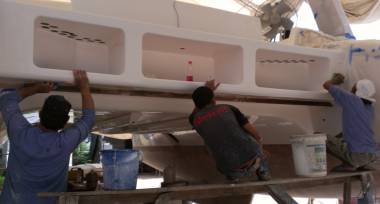 Pla, Baw, & Lek starting the long gelcoat polishing procedure |
Amanda gave Sue more scooter driving lessons, and was even brave enough to ride behind her for a few blocks. Sue is mentally rehearsing the procedures for driving the manual scooter, which is less intuitive than an automatic, totally different from a manual car, and similar only to the dinghy in that your hand rotation controls the throttle. We will sure miss Amanda when she leaves next week, for gazillions of reasons, but the relevant one here is that Amana has been the scooter gofer, and Sue may have to take over that job.
Saturday, May 18:
A sunny but slow end to the week. Houa pulled a muscle in his neck so was out for the day,
and Ben was out for the day as well, so it was just Baw, Pla, and Lek. Unfortunately, Houa
left the tools locked up, so we had to look for alternatives to do the work we needed to do.
Today was a pretty mellow day. Baw, Pla and Lek spent all day wet sanding the new gelcoat back on the aft deck, in the lazarettes aft of the cockpit, and in the cockpit itself. The goal here is to get the first bumps off the gelcoat with 240 grit sandpaper while the gelcoat is still really fresh and not too hard. The longer you wait after the spray, the harder the gelcoat gets, until reaching maximum hardness in about 10 days.
Amanda and Jon were the really productive ones. Amanda is really good at marking (for Jon to cut out) nonskid templates with curved sides, so we wanted to finish as many of those as we could before she leaves Monday night. Today they worked on the bows and the areas next to the 2 outer aft corners of the trampolines. These are difficult areas because the hull slopes away and the deck turns in unexpected ways. To get a nice curve that follows the hull shape and lies only on the flat part of the deck is part math, part engineering and part art. How do you make a curve that follows the shape of the deck when the curve from the deck to the hull is constantly changing - in BOTH directions! Jon and Amanda make a great team for this sort of thing - using tools to make other tools that make the (template) tool that Mike will use to shape the nonskid. By the end of day they had the starboard triangular bow template made (and no, port is not a mirror image of starboard) and the 2 "L" shaped pieces that go around the 2 outer aft corners of the trampolines.
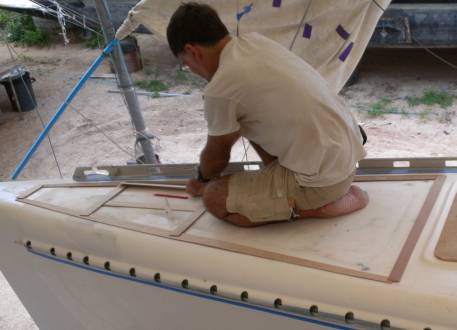 Jon putting together the port bow template, with a cleat cutout in the middle |
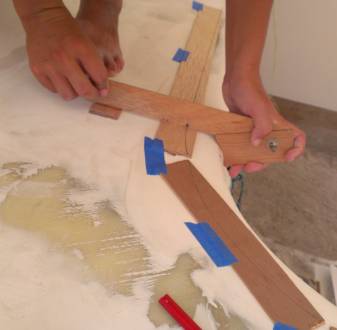 Amanda using our curve following tool to mark a nice line |
We are so happy to plan and execute the nonskid templates ourselves. No telling how and where a (non‑mathematical) worker would have put the nonskid. Baw has taped off nominal nonskid lines several times, and they look pretty good at first glance, but the distances away from hatches and other hardware were not at all consistent, and the corners were not consistent either. With time, those lines would have driven us nuts. Besides the big, gentle curves that follow the hull, we're only using 2 different corner diameters - one small (2.4" or 6 cm) for most external corners, and one big (4.9" or 12.4 cm) for most internal corners. And distances between the nonskid and bits of deck hardware is pretty consistent as well - 1" (25 mm) from small fittings and 1¼" (30 mm) from bigger fittings. There's a bit of a trade‑off here, as spacing the nonskid closer to other deck fittings (including other pieces of nonskid) gives better footing but tends to show up more flaws (like pieces not cut or laid quite straight).
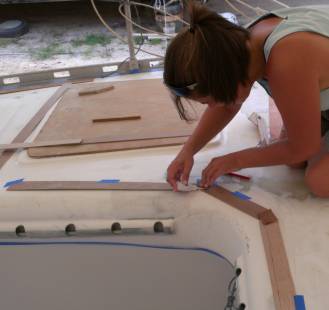 Super-gluing sections together so Jon can cut to her line |
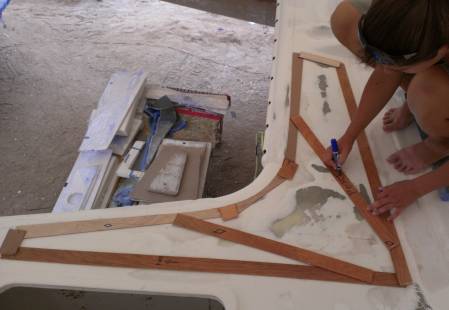 The final, assembled portside template |
Sue spent the day practicing scooter driving, taking pictures, and cleaning up more bits of hardware. We so want to be ready for the reassembly of Ocelot when the time comes!
We left the yard early so that Amanda could check out of her room and move all her stuff (what's going to the USA with her, and what's staying behind) into our room. We all showered, then with a rented motorcycle to supplement our own, we battled rush hour traffic 1 hour north to Ao Po to meet cruising buddies Bruce and Alene of the Cross trimaran, Migration. A whole weekend of dinner out, brunch in the condo, swimming, BBQ and party‑ing is planned for us for the joint events of our 34th wedding anniversary and Amanda's return to the USA. Tally HO!
Thai Refit:
Ocelot Pages:
Top Level: Home | Destinations | Cruising Info | Underwater | Boat Guests | Ocelot | Sue | Jon | Amanda | Chris | Site Map | Make a Comment
|
If our information is useful, you can help by making a donation |
Copyright © 2000‑ Contact: Jon and Sue Hacking -- HackingFamily.com, svOcelot.com. All rights reserved.